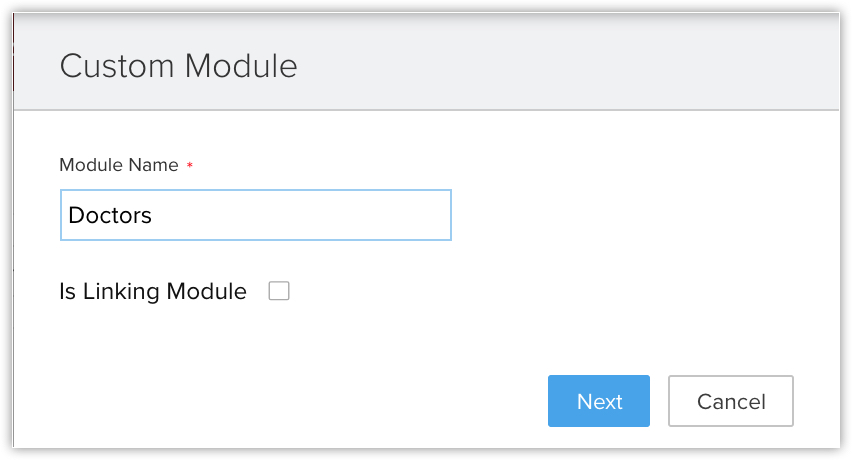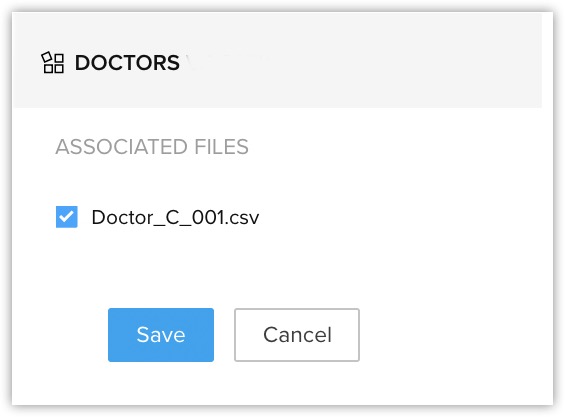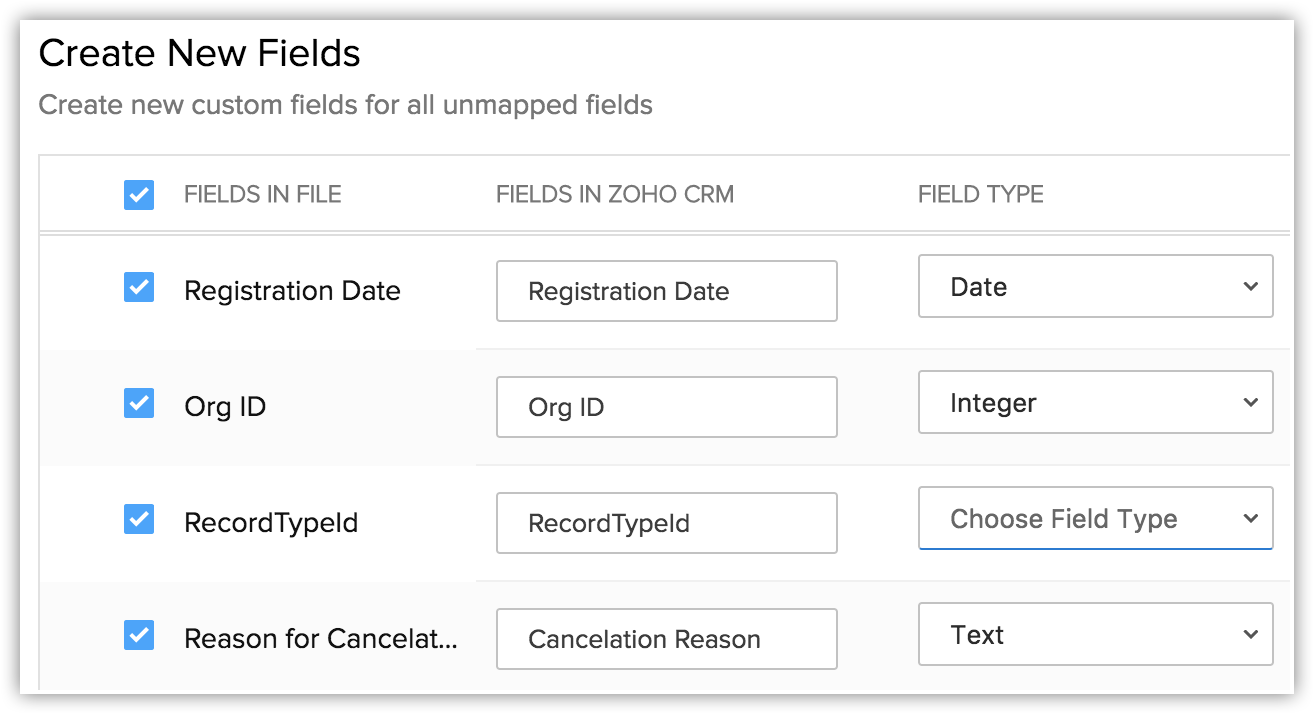Migrating from Salesforce to Zoho CRM
Data files from Salesforce
The zip file you upload should contain all the files in CSV format and a folder named Attachments. This folder contains the source files used as attachments in Salesforce records. One of the CSV files will list the record of attachment mappings. This will be used to retain the records' association with the attachment files.
Data from any custom modules that you created in Salesforce will be stored in files with a "_c" suffix on the file name. (e.g., registrations_c.csv).
All your data should be in the format described above. When you save the data backup to your local drive, it is a good idea to extract the files to check that the format matches and compress them again for import. This may sometimes create additional folders. If there are any additional folders in the zip file, uploading your file may fail. The data backup from Salesforce will have additional folders named Attachments, Documents and Content Version. These folders will not cause the migration to fail.
Modules Mapping
You can migrate the following supported modules to Zoho CRM from Salesforce account:
|
|
Migrate data
To migrate data
- Log in to Zoho CRM with Administrative privileges.
- Go to Setup > Data Administration > Import.
- In the Data Migration page, choose Salesforce.
- In the pop-up, browse for and upload the files.
You can select multiple files or upload a zip file to migrate data into more than one module. - Click Next.
Zoho CRM automatically reads the files and maps the data to the correct modules and fields. -
You can do the following in the Module-File Mapping section:
- View the mapped and unmapped modules separately.
- Click on a file and see which module it is mapped to.

- View the mapped, unmapped and unsupported files separately.
- Click the Discard Migration link to start again.
- View the mapped and unmapped modules separately.
-
Click on a module to view the files that have been mapped to it.
You can also select from the Unmapped files and map them. Multiple files can be mapped at the same time.
You can also create a new module and map the appropriate file.
To create a new module, do the following:
- Click Create New Module.
Alternately, you can use the custom modules suggested by CRM (modules starred yellow). - Enter the module name and click Next.

- Select the file to be mapped with this module and click Save.

- Click Create New Module.
- Click Next.
The mapped modules will be listed where you can map the fields for each module. - In the Field Mapping tab, make sure that you map all the mandatory fields.
The fields present in Zoho CRM will be available in the drop-down lists. - Click Create New Fields to add new fields and insert data for them before or during the migration.
The number of fields that you can create depends on your Zoho CRM edition. (Skip to step 12 if you do not want to create fields.) -
In the Create New Fields pop-up, do the following:
- Modify the field labels, if required.
All the fields from the import file that were not mapped for migration because they are not available in Zoho CRM will be listed with their column numbers from the import file.

- Select the Field Type from the drop-down list.
Formula field will not be available. You cannot create this field during migration. - Click Create.
The field will be created and mapped to the columns in the import file. - Click Close to continue the migration process.
- Modify the field labels, if required.
- Click Mapped Fields and Unmapped Fields to view the columns that are mapped and not mapped respectively with the fields in Zoho CRM.
-
Click the Reset Mapping link to start mapping from scratch.
Any mapping you have done so far will be removed and you can start over.
-
Click the Auto Map link to let CRM map the import columns with matching fields.
The system will identify columns that match the CRM fields and map them automatically.
-
Hover over the field and enter the field values in the Replace Empty Values text box.
Sometimes the field in an import file doesn't have a value, in case that field is marked mandatory in CRM, the record will not be imported because of absence of value. To avoid such situations, you can mention an alternate value that will replace the empty field.
For example, you have mapped the Last Name field from the file with the Last Name field in the Leads module, which is mandatory. So without the field value, the record will be skipped during the import process. To avoid that, you can specify the value that should replace the empty Last Name field. -
Hover over the field and click the Add (+) icon next to the field name and map multiple fields in CRM with a single field from the file.
For example, if the Billing Address and the Shipping Address are same you can map both these CRM fields to the appropriate fields from the file. -
Click the Assign Default Values tab and select the CRM Fields with the appropriate Default field values.
Once the values are specified, all the records will have the field value that you have specified by default. For example, you are importing a set of records to the Leads module and the Lead Source is common for all the records. The appropriate value for the lead source can be chosen here so that all the records will have the specified field value by default.
- Click Save and Next.
- In the Review page, check the Field Mapping Status and the Pre Migration Statusfor Each Module.

- Click Start Migration to initiate data migration.
You can still click Edit Mapping and re-run Migration while the migration is running.

-
Tags can be migrated from your file into CRM.
- If a record has more than 10 tags, only the first ten tags will be migrated.
- Each tag can have a maximum of 25 characters.
- If a record has more than 10 tags, only the first ten tags will be migrated.
- Then data migration will be paused if more than 5000 records in a module are skipped during the migration. You will have the option to discard the migration or continue. Zoho CRM will also inform you for each module if more than 5,000 records are skipped.
- You can undo the data migration from Import History. See Also Viewing Import History
Check for Data Accuracy
If you are not satisfied with the import or field mapping results, you can delete the imported records and re-import.
Related Articles
Migrating from Sugar CRM to Zoho CRM
Welcome to Zoho CRM! Migrating your data from Sugar CRM to Zoho CRM can be done seamlessly using our data migration feature. All you need is to have an export file from Sugar, ready to use. Click here to learn to export data from their CRM. Before ...Migrating Data Between Zoho CRM Accounts
Retrieve Data files from Zoho CRM If you are planning to use a backup of data from Zoho CRM to import, the file structure does not change. If you exported data from another CRM, use the following folder structure: The Data folder should contain all ...Migrating from Bigin to Zoho CRM
You can migrate your data from Bigin to Zoho CRM by uploading a data backup of your Bigin account into your Zoho CRM account. This involves only a few steps, as mentioned below. Pre-requisites: To initiate the migration of your data from Bigin, you ...Migrating from Capsule to Zoho CRM
The migration process from Capsule to Zoho CRM relies on APIs and Instance URLs. To initiate the migration, simply input the API key. The entire migration occurs in the backend, and upon completion, you'll receive an email notification. You have the ...Migrating from Bitrix to Zoho CRM
Migration from Bitrix to Zoho CRM is carried out using inbound webhook only. You can initiate the migration by entering the inbound webhook in the instance URL. The entire migration will take place in the backend and you will be sent an email ...